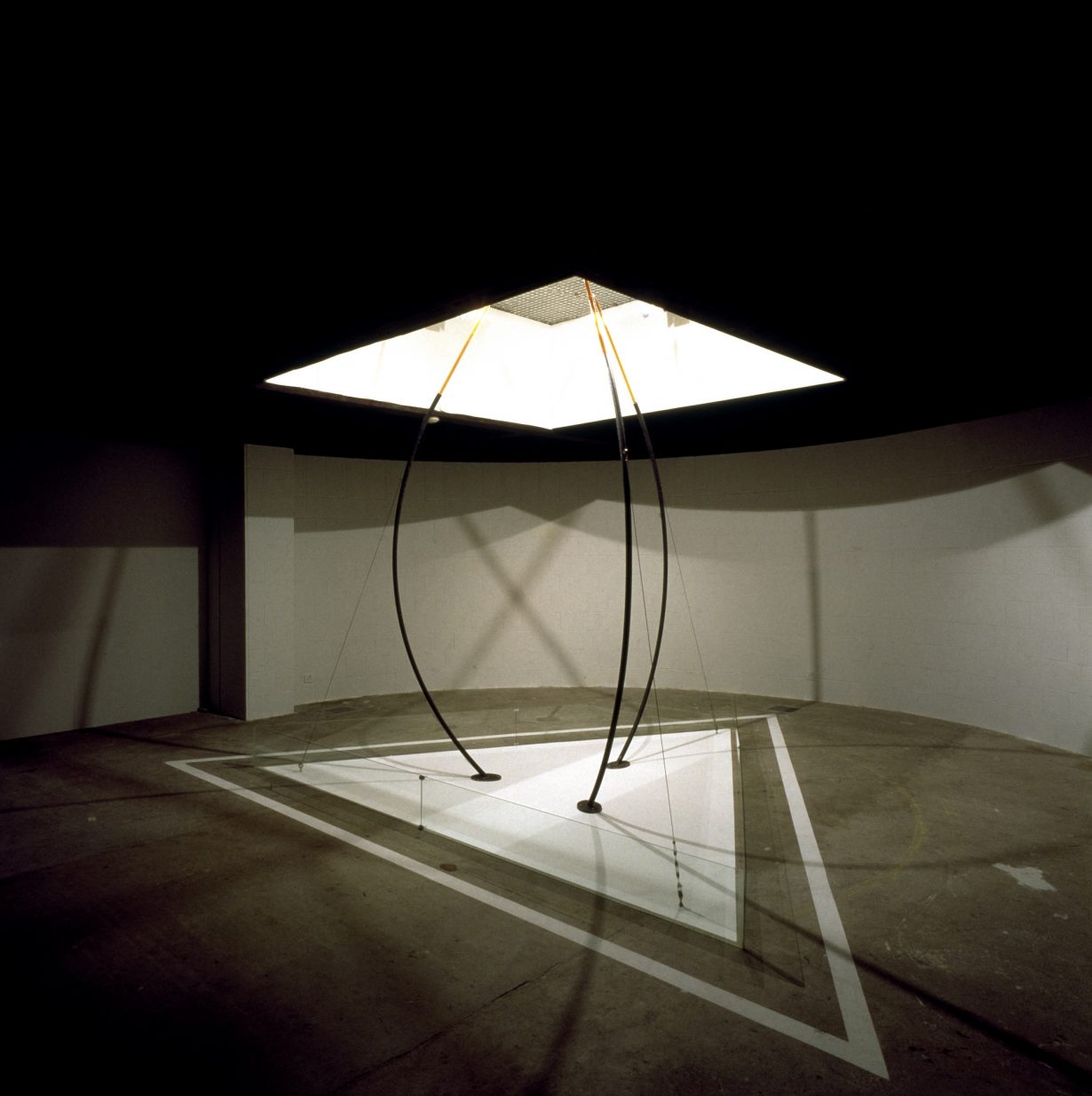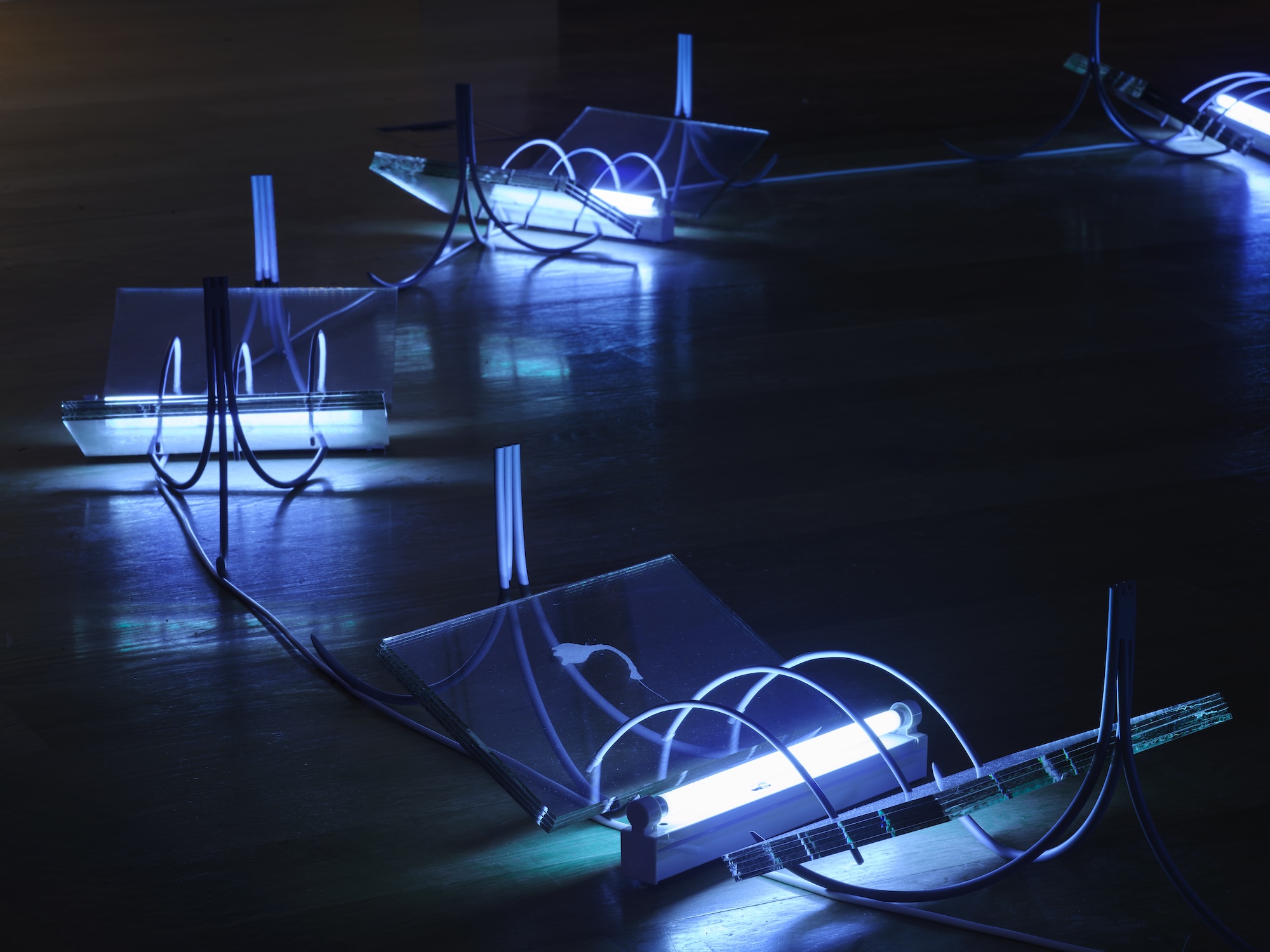Apprehensions at IMMA, Dublin captures how the late artist laced aesthetic elegance and refinement with lethal danger
Hamad Butt’s artworks attract and repel in almost equal measure. Some replicate the refined appeal of sleek minimalism; others resemble tools we routinely handle or toys we might play with; still others invite scrutiny of elliptical texts or indistinct drawings. Yet while the work of the late Lahore-born British artist – who died in 1994, aged thirty-two, of an aids-related illness – conveys idiosyncratic charm, it is often more forcefully distinguished by a potential to inflict harm. In Familiars, a trio of works from 1992, he employed substances (poisonous gases, volatile liquids) that, though contained in sealed vessels as part of a sculptural grouping, could, as curator Gregor Muir wrote when recalling the incautious behaviour of guests at a 1994 exhibition opening, ‘kill everyone in the room’. Crafted elegance, aesthetic refinement: such qualities are, in Butt’s work, laced with latent, sometimes lethal, danger.
Apprehensions, the artist’s first-ever retrospective and first showing outside of the UK, is a gathering of key pieces and assorted experiments that captures the double-edged spirit of Butt’s protean art. Realised by IMMA and London’s Whitechapel Gallery (to where it travels in June), the show makes a lot out of an understandably limited body of work. At its centre are two signal installations from the four exhibitions staged during Butt’s lifetime: elaborate, multipart, multimedia compositions, one from a formative point in his brief career, the other from near its untimely end – dates that came tragically close together. The first, Transmission, staged as his Goldsmiths degree show in 1990, featured a floor-based circle of nine etched-glass sculptures shaped like opened books, each lit by a spinelike tube of searing UV light, in combination with other components including a wall-mounted vitrine housing a colony of flies feasting on sugar-paper signs. In the glass ‘books’, small illustrations of ghastly plant-animal entities, inspired by cover art from a paperback edition of John Wyndham’s 1951 novel, The Day of the Triffids, encourage detailed study. But come too close and the light will damage your eyes; hence, as in previous presentations, the offer of anti-UV glasses.
In the glass-fronted display case, statements printed on the sugar paper essay oblique thoughts on themes relevant to Butt’s experience of HIV and AIDS: contagion, fear, the abandonment of intimacy. These textual ‘transmissions’ hint at hoped-for connection, meaningful communication. But to receive them, we must also witness the repulsive theatre of the flies’ relentless, meaningless life cycle – and as they multiply, feeding on the pages, they consume the texts. (In the catalogue, Apprehensions curator Dominic Johnson recalls how Butt chose to cut the fly vitrine from Transmissions after seeing Damien Hirst’s then new A Thousand Years several months later in 1990, feeling that Hirst’s fly-infested-cow’s-head conceit was too heavily based on his own bio-art proposition; since lost, this element of the work has been reconstructed.)

The second essential installation in Butt’s curtailed oeuvre is the last major work he completed, the aforementioned triptych Familiars. All three imposing Familiars present risks to gallery visitors. Cradle borrows the form of a ‘Newton’s Cradle’, scaling up this desktop toy and replacing swinging, clicking steel balls with nine glass spheres of piss-coloured chlorine. Pull and let go of one fragile bauble – as we might to test the device’s cause-and-effect action – and it would smash, releasing corrosive fumes. Each glass rung in the ladder structure of Substance Sublimation Unit contains iodine crystals and a heating element: climb onto the ladder and the glowing steps could crack, risking exposure to toxic vapour. In Hypostasis, three tall curved, pointed metal poles, formally alluding to the shape of an Islamic arch and so also to the artist’s Pakistani heritage, are tipped with bromine-filled tubes. Should you step inside the arch – seeking, perhaps, spiritual significance – your feet might catch on the sculpture’s supporting tethers, toppling the structure, shattering the glass, spilling the noxious bromine.
Apprehensions augments the Hamad Butt canon with an array of lesser-known paintings, prints, drawings and poems. Among these, a series of exploratory pencil-and-pastel works made during the development of Transmissions – thin dotted lines, isolated architectural details, fragmented human forms – sensitively complements the resulting installation’s dystopian provocations. Earlier, pre-art-school studies of nude male forms are less distinctive, representing the gestural yearnings of a talented but still-callow artist. That said, they picture male bodies, queer bodies, together and apart, with undeniable energy; in an exhibition infused with threats of contamination, haunted by the trauma of illness and loss, their vitality is heartening – even if, unhappily, we know the hard truths of how this story ends.
Apprehensions at IMMA (Irish Museum of Modern Art), Dublin, through 5 May
From the March 2025 issue of ArtReview – get your copy.
